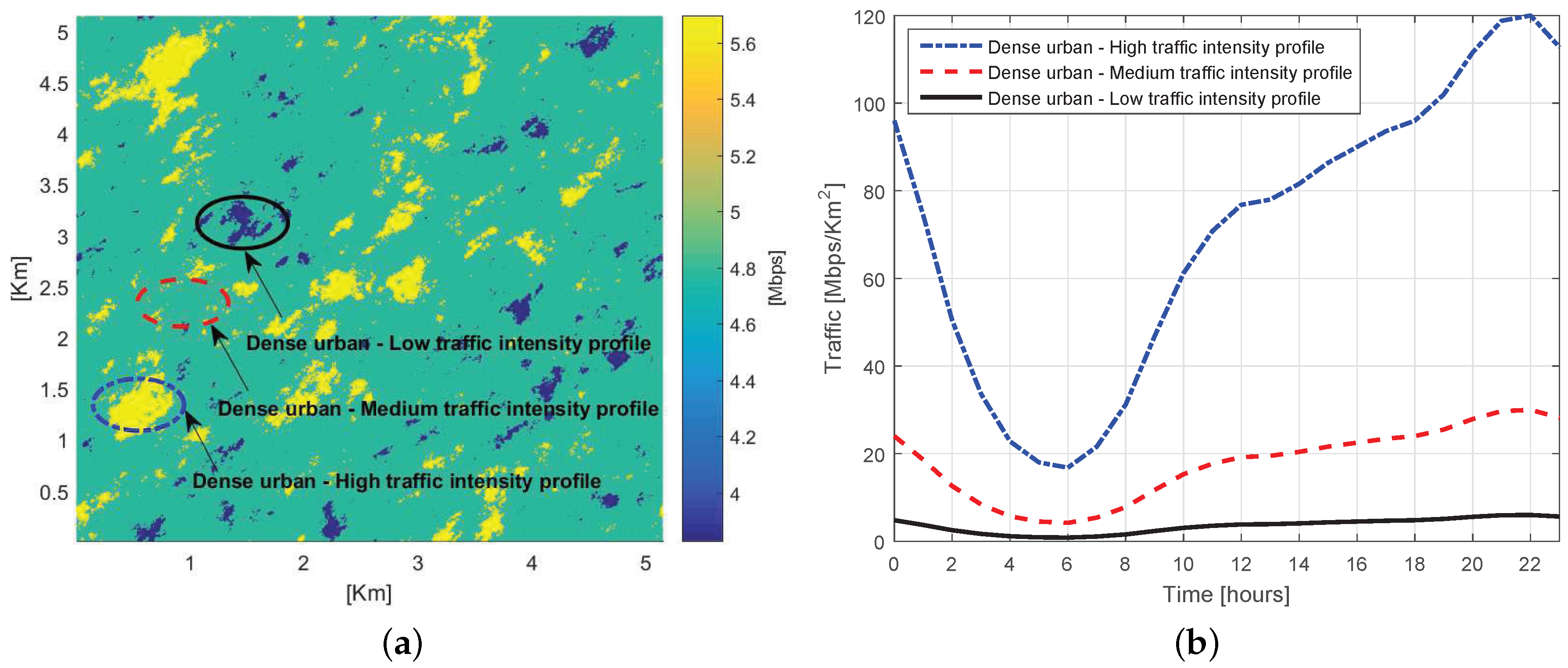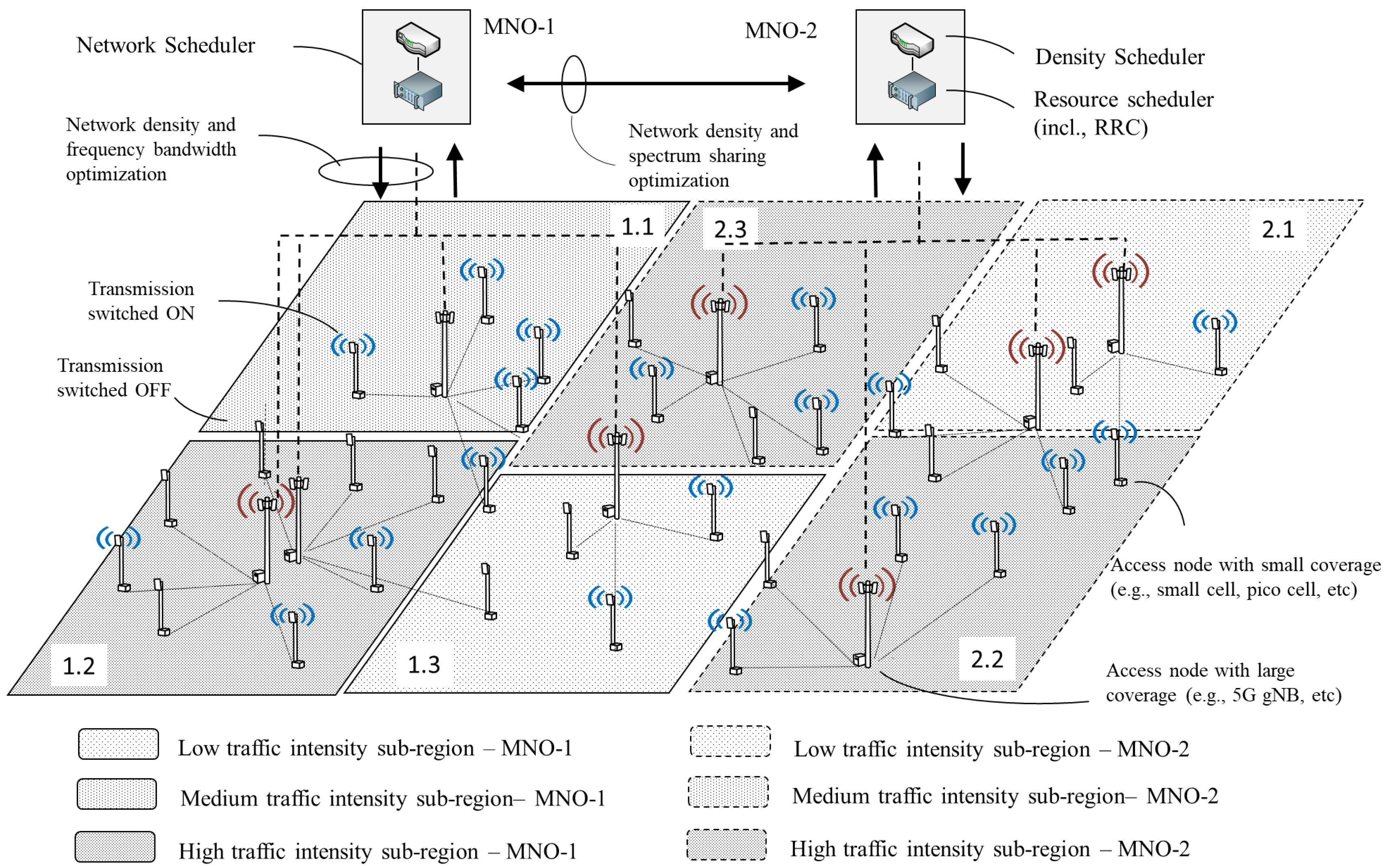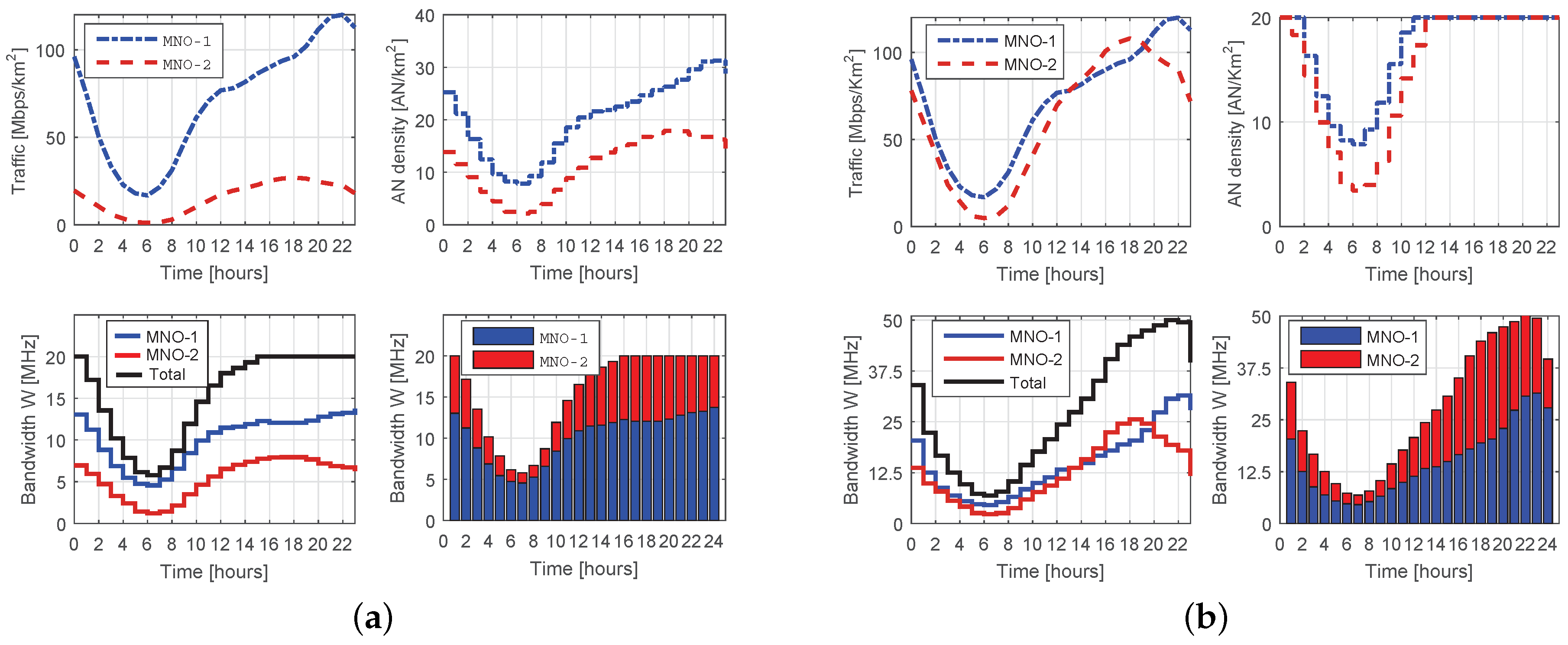Trading off Network Density with Frequency Spectrum for Resource Optimization in 5G Ultra-Dense Networks
Abstract
1. Introduction
2. Basic Concepts, Assumptions and Models
2.1. Flexible RRM Algorithms
2.2. User Capacity in Dense Networks
2.3. Traffic Model
2.3.1. Long-Term Large-Scale Traffic Model
- Define the average served data rates per user;
- Define the percentage of active users;
- Derive the deployment-specific peak data rate per unit area (Mbps/km), given the population densities of the respective deployment scenario;
- Determine the deployment-specific data rates per unit area for a given time of the day with the aid of a daily traffic profiles.
- High traffic intensity profile: 2.0 Mbps/user;
- Medium traffic intensity profile: 0.5 Mbps/user;
- Low traffic intensity profile: 0.1 Mbps/user.
- Percentage of radio broadband data subscribers: of the whole population;
- Percentage of active users in busy/peak hours: of the users;
2.3.2. Traffic Intensity Maps
2.4. Traffic Constraints
3. Joint Network Density and Frequency Spectrum Optimization
3.1. Network Density and Spectrum Scheduler
3.2. Multi-Operator Spectrum Sharing
| Algorithm 1 Jointly optimal frequency bandwidth and network density scheduler. |
|
3.2.1. Exclusive Spectrum Allocation
| Algorithm 2 Jointly network density and spectrum sharing. |
|
3.2.2. Non-Exclusive Spectrum Allocation
3.2.3. Frequency Spectrum Location
| Algorithm 3 Resource scheduling of frequency spectrum. |
|
4. Numerical Results
4.1. Network Density and Frequency Bandwidth Optimization
4.2. Network Density and Spectrum Sharing Optimization
5. Conclusions
Author Contributions
Funding
Acknowledgments
Conflicts of Interest
Appendix A. Analysis of Joint Network Density and Frequency Spectrum Optimization Problem
Appendix A.1. Convexifiability
Appendix A.2. Globally Optimal Solution
Primal Variables Updates
Dual Variables Updates
References
- Andrews, J.G.; Buzzi, S.; Choi, W.; Hanly, S.V.; Lozano, A.; Soong, A.C.K.; Zhang, J.G. What will 5G be? IEEE J. Sel. Areas Commun. 2014, 32, 1065–1082. [Google Scholar] [CrossRef]
- Yu, A.M.; Kim, S.L. Downlink capacity and base station density in cellular networks. In Proceedings of the IEEE WiOpt Workshop on Spatial Stochastic Models for Wireless Networks, Tsukuba, Japan, 13–17 May 2013. [Google Scholar]
- Galiotto, C.; Marchetti, N.; Doyle, L. The role of total transmit power on the linear area spectral efficiency gain of cell splitting. IEEE Commun. Lett. 2013, 17, 2256–2259. [Google Scholar] [CrossRef]
- Koudouridis, G.P.; Soldati, P. Spectrum and Network Density Management in 5G Ultra-Dense Networks. IEEE Wirel. Commun. 2017, 24, 30–37. [Google Scholar] [CrossRef]
- Hadzialic, M.; Dosenovic, B.; Dzaferagic, M.; Musovic, J. Cloud-RAN: Innovative Radio Access Network Architecture. In Proceedings of the Electronics in Marine-2013, Zadar, Croatia, 25–27 September 2013; pp. 115–120. [Google Scholar]
- Eramo, V.; Listanti, M.; Lavacca, F.G.; Iovanna, P.; Bottari, G.; Ponzini, F. Trade-Off Between Power and Bandwidth Consumption in a Reconfigurable Xhaul Network Architecture. IEEE Access 2016, 4, 9053–9065. [Google Scholar] [CrossRef]
- Oikonomakou, M.; Antonopoulos, A.; Alonso, L.; Verikoukis, C. Evaluating Cost Allocation Imposed by Cooperative Switching Off in Multioperator Shared HetNets. IEEE Trans. Veh. Technol. 2017, 66, 11352–11365. [Google Scholar] [CrossRef]
- Antonopoulos, A.; Kartsakli, E.; Bousia, A.; Alonso, L.; Verikoukis, C. Energy-efficient infrastructure sharing in multi-operator mobile networks. IEEE Commun. Mag. 2015, 53, 242–249. [Google Scholar] [CrossRef]
- Yang, Y.; Sung, K.W. Tradeoff between Spectrum and Densification for Achieving Target User Throughput. In Proceedings of the 2015 IEEE 81st Vehicular Technology Conference (VTC Spring), Glasgow, UK, 11–14 May 2015; pp. 1–6. [Google Scholar]
- Mesodiakaki, A.; Adelantado, F.; Alonso, L.; Renzo, M.D.; Verikoukis, C. Energy- and Spectrum-Efficient User Association in Millimeter-Wave Backhaul Small-Cell Networks. IEEE Trans. Veh. Technol. 2017, 66, 1810–1821. [Google Scholar] [CrossRef]
- Eramo, V.; Listanti, M.; Lavacca, F.; Iovanna, P. Dimensioning models of optical WDM rings in xhaul access architectures for the transport of Ethernet/CPRI traffic. Appl. Sci. 2018, 8, 612. [Google Scholar] [CrossRef]
- Stine, J.A.; Bastidas, C.E.C. Enabling Spectrum Sharing via Spectrum Consumption Models. IEEE J. Sel. Areas Commun. 2015, 33, 725–735. [Google Scholar] [CrossRef]
- Andrews, J.G.; Baccelli, F.; Ganti, R.K. A tractable approach to coverage and rate in cellular networks. IEEE Trans. Commun. 2011, 59, 3122–3134. [Google Scholar] [CrossRef]
- Koudouridis, G.P.; Soldati, P. Joint network density and spectrum sharing in multi-operator collocated ultra-dense networks. In Proceedings of the 2018 7th International Conference on Modern Circuits and Systems Technologies (MOCAST), Thessaloniki, Greece, 7–9 May 2018; pp. 1–4. [Google Scholar]
- Koudouridis, G.P.; Soldati, P.; Lundqvist, H.; Qvarfordt, C. User-centric scheduled ultra-dense radio access networks. In Proceedings of the 23rd International Conference on Telecommunications (ICT 2016), Thessaloniki, Greece, 16–18 May 2016; pp. 1–7. [Google Scholar]
- Haenggi, M. Stochastic Geometry for Wireless Networks; Cambridge University Press: Cambridge, UK, 2013. [Google Scholar]
- Park, J.; Kim, S.L.; Zander, J. Asymptotic behavior of ultra-dense cellular networks and its economic impact. In Proceedings of the 2014 IEEE Global Communications Conference, Austin, TX, USA, 8–12 December 2014; pp. 4941–4946. [Google Scholar]
- Ferenc, J.S.; Neda, Z. On the size distribution of Poisson Voronoi cells. Phys. A Stat. Mech. Appl. 2007, 385, 531–533. [Google Scholar] [CrossRef]
- Koudouridis, G.P.; Soldati, P. Capacity model for network density scheduling in small cell networks. In Proceedings of the 2016 23rd International Conference on Telecommunications (ICT), Thessaloniki, Greece, 16–18 May 2016; pp. 1–6. [Google Scholar]
- Auer, G.; Blume, O.; Giannini, V.; Godor, I.; Imran, M.A.; Jadin, Y.; Katranaras, E.; Olsson, M.; Sabella, D.; Skillermark, P.; et al. EARTH Deliverable D2.3: Energy Efficiency Analysis of the Reference Systems, Areas of Improvements and Target Breakdown; Technical Report, Seventh Framework Programme; INFSO-ICT-247733 EARTH. 31 January 2012. Available online: https://cordis.europa.eu/docs/projects/cnect/3/247733/080/deliverables/001-EARTHWP6D62b.pdf (accessed on 25 October 2018).
- Gotzner, U. Spatial Traffic Distribution in Cellular Networks. In Proceedings of the IEEE Vehicular Technology Conference, Ottawa, ON, Canada, 21 May 1998. [Google Scholar]
- Furuskär, A.; Almgren, M.; Johansson, K. An infrastructure cost evaluation of single- and multi-access networks with heterogeneous traffic density. In Proceedings of the Vehicular Technology Conference (VTC-Spring), Stockholm, Sweden, 30 May–1 June 2005; pp. 3166–3170. [Google Scholar]
- Bertsekas, D.P. Nonlinear Programming; Athena Scientific: Belmont, MA, USA, 1995. [Google Scholar]








| Deployment | Population Density (citizens/Km) | Traffic Profile (Mbps/Km) | ||
|---|---|---|---|---|
| High | Medium | Low | ||
| Dense urban | 3000 | 120.0 | 30.0 | 6.0 |
| Urban | 1000 | 40.0 | 10.0 | 2.0 |
| Sub-urban | 500 | 20.0 | 5.0 | 1.0 |
| Rural | 100 | 4.0 | 1.0 | 0.2 |
© 2018 by the authors. Licensee MDPI, Basel, Switzerland. This article is an open access article distributed under the terms and conditions of the Creative Commons Attribution (CC BY) license (http://creativecommons.org/licenses/by/4.0/).
Share and Cite
Koudouridis, G.; Soldati, P. Trading off Network Density with Frequency Spectrum for Resource Optimization in 5G Ultra-Dense Networks. Technologies 2018, 6, 114. https://doi.org/10.3390/technologies6040114
Koudouridis G, Soldati P. Trading off Network Density with Frequency Spectrum for Resource Optimization in 5G Ultra-Dense Networks. Technologies. 2018; 6(4):114. https://doi.org/10.3390/technologies6040114
Chicago/Turabian StyleKoudouridis, Georgios P., and Pablo Soldati. 2018. "Trading off Network Density with Frequency Spectrum for Resource Optimization in 5G Ultra-Dense Networks" Technologies 6, no. 4: 114. https://doi.org/10.3390/technologies6040114
APA StyleKoudouridis, G., & Soldati, P. (2018). Trading off Network Density with Frequency Spectrum for Resource Optimization in 5G Ultra-Dense Networks. Technologies, 6(4), 114. https://doi.org/10.3390/technologies6040114





